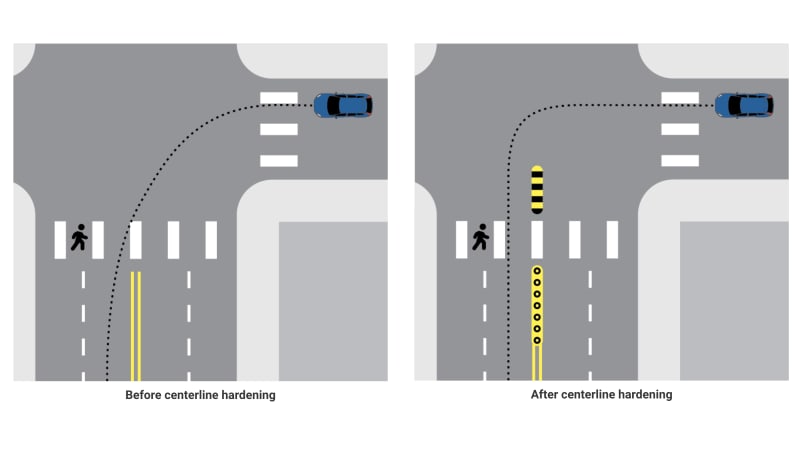Adding these obstacles at intersections could reduce left-turn pedestrian accidents
https://ift.tt/2RxCITH

A new study released by the Insurance Institute for Highway Safety (IIHS) suggests a few small infrastructure changes at intersections could help reduce the number of pedestrian injuries when vehicles are turning left. A possible solution — bollards and rubber curbs — encourages drivers turning left to slow down, pay attention, and make more deliberate maneuvers.
According to the IIHS, more than half of all crashes in the United States in 2018 occurred at intersections. The accidents included more than 6,700 serious injuries and more than 1,500 pedestrian deaths. Throughout 2018, more than one-third of those car-into-pedestrian crashes happened when a vehicle was making a left turn.
The IIHS believes a method called centerline hardening could make left-hand turns safer for pedestrians. Centerline hardening uses bollards, those skinny orange or yellow traffic poles, and rubber curbing to create an obstacle vehicles are forced to drive around. Without hardening, drivers often cut diagonally across the intersection at higher speeds. With hardening, the driver has to drive deeper into the intersection and make a turn closer to a 90-degree angle.
IIHS Senior Research Transportation Engineer Wen Hu studied the effect of centerline hardening in Washington, D.C. Through his research, he found that the “calming infrastructure” changes reduced the number of “conflicts,” which are defined as “the times drivers had to swerve or brake suddenly or pedestrians had to dodge out of the way,” by 70%. He also found the bollards and curbs reduced driver speeds during left turns and resulted in 36% less left-turns made at 15 mph or faster. The study points out the odds of seriously injuring a person rise from 10% to 25% as left-turn speeds increase from 17 mph to 25 mph.
Hu’s study covered data from 10 intersections in D.C. during a time period of two months before the changes and three months after the changes. He then compared his findings with eight control sites that did not have centerline hardening. The information was collected during daytime and in dry conditions. At these 10 intersections, Hu observed an average of about 200 drivers making left turns during a six-hour window. Hu further notes that most of the reduction in conflicts largely occurred at two of the observed intersections.
These methods are not new and are already in use throughout the country. New York City, for example, has installed centerline hardening techniques at more than 300 intersections since 2016.
For more information on the study and data, read Hu’s full paper on the IIHS website.
Auto Blog
via Autoblog https://ift.tt/1afPJWx
April 12, 2020 at 11:55AM
